Refugee Activism in Brisbane - Rallying, Marching, Chanting or Winning?
Yesterday in Queens Park, in downtown (CBD) Brisbane, Australia about 300 people went to a rally to back refugee rights - the Queensland branch of the Refugee Action Collective organised the rally to mark World Refugee Day. After 45 minutes of speeches, people marched 3.2 km (2 mi) around city streets, over the Queen Victoria Bridge and along Clem Jones Promenade, Southbank, to the grassy forecourt outside the Webb Building, Griffith University Southbank Campus, site of Kate Durham's exhibition, “Keeping the Flame of Hope Alive”.

NOT public domain. From this website
Queen's Park, Brisbane.
The rally was centred around new laws that the Australian Federal Government wants to bring in, which will mean that anyone who reaches Australia by sea will automatically be not allowed to enter the country, even if they do turn out to be refugees.
I arrived at Anne Street's Central Station in town, at about 10.45 am. I walked down Edward St to the corner of Adelaide St, outside the entrance to the upmarket Queen's Plaza shopping centre. A homeless man was selling a copy of The Big Issue, with the word 'REFUGEE' in big letters on the front cover. I didn't have my copy yet this fortnight, so I bought one from him. The cover refers to the bitter story of Richard Okao, a Ugandan refugee. Buy your copy today from vendors on the streets of central Brisbane (and cities right around the country) up to Sunday July 2nd – your vendor keeps $2 from every copy sold. 07 3220 3775 for more information from the Brisbane office
(+617 3220 3775 outside Australia) or www.bigissue.org.au for contact details for outher cities.
I walked through Queen's Plaza to the Queen St Mall, along the mall to Albert St, down Albert St to Elizabeth St, and along Elizabeth to Queen's Park, on the corner of Elizabeth and George Streets. I hit the park just before 11am, to find a stage set up, along with several stalls. About 50 people were milling around. Since no-one was speaking yet, I browsed the stalls – they belonged to the Refugee Action Collective, Socialist Alternative, Socialist Alliance, the Socialist Action Group, and Amnesty International (Brisbane). After a few minutes of browsing, I lay down on the grass to watch the scene.
Two people from Socialist Alternative wandered around selling copies of the magazine I had just bought. A man from the Refugee Action Collective handed me a petition and a flyer for their regular meetings, and another hander-outerer gave me a Hiroshima Day flyer.
And then I saw a sight that these days only rewards the most patient political observer – two Australian Democrats, apparently bred in the wild, and not hand reared. The Democrats were once the dominant minor party in Australian politics, with senators from most states and the balance of power in Australia's Senate, which has great powers to block new laws. But after the party ripped itself apart in 2002, it seems that their Left voters moved to the Greens, and centrist or liberal-Right supporters returned to the Liberal Party of Australia. They now have a great deal of trouble even getting candidates to stand, let alone getting volunteers to polling booths to hand out 'how-to-vote' leaflets on polling day. Seeing any form of organised presence from Democrats is indeed rare, now.
At 11.17am, I heard someone speaking from the stage. The microphone was very soft. I would have been 20 metres away from the single small speaker, and could hear almost nothing. I wonder if a sound check had been done. It did help to get people gather in closely, but if 1 000 people had turned up, they would have been disappointed. About half an hour after the speakers started, someone played with the knob on the speaker and turned the sound up so that it was easier to hear. This sort of thing must be done and checked before rallies start.
Sharman Shah, an Afghan refugee, talked about what he saw when he was a prisoner in Australia's
offshore refugee 'processing' camps:
For the first six or seven months there was no power, and it was always hot – no airconditioning or powered fans could be used. Skin cancers and eye infections were common, and there was a water shortage. People had to line up for an hour each day for water, and if you did not or could not line up, then you just did without water for 24 hours.
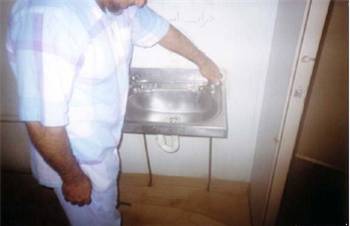
NOT public domain - from this site
No Water

NOT public domain - from this site
Shah asked the rally to imagine what you could expect of a child who was born into a place like a refugee prison. Even those people who were allowed out of Nauru are not allowed to apply for long-term visas – the uncertainty just adds to stress and mental problems.

NOT public domain - from this site
Prisoners of Australia
Dee Dicen Hunt spoke about the case of Vivian Solon, an Australian citizen illegally deported to the Philippines by the Australian Government. Hunt specifically wanted to give people ammo to shot down the bad arguments used by some people to make Solon's case look not so bad for the Government – especially now that her claim for compensation from the Government is in the public eye.
First of all, Solon was an Australian citizen, with an Australian passport. If the right checks had been done, she would never have been deported in the first place.
The reason that Solon was noticed by the authorities in the first place was that she was in a car crash. Since she was deported, she could not use her right to claim for compensation for the crash. That is one of the reasons why she is claiming compensation.
One of the excuses that is put about by defenders of the Government is that Solon 'gave different names' to the Government. Hunt pointed out that 'many people have more than one name' – especially women, who commonly use two names in their life if they get married, and often revert to a former name following a divorce.
NOT public domain, from this site
Vivian Solon, the Australian citizen illegally deported by the Government.
There were also lies spread that Solon was a worker in the sex industry, and that her injuries were the result of being attacked by a client.
[Author's note: I support a legal sex industry, out of the hands of the Vice Squads, and do not personally feel it is a slur on anyone to have been a sex worker. However, it is a common slur to many people and the story would have been spread to try and lessen her popular support]
When Solon was deported to Manila, she was dumped at the airport, due to lazy or negligent planning by the Government. She was sent to a hospice for the dying poor. Even though she was treated 'very nicely' by the nuns there, she had no hope of getting the care she needed – she needed back surgery and rehabilitation, not to be made comfortable while she slipped away from life.
Meanwhile, the Australian Government had lost track of her, and only found her by luck. Her case is still in arbitration. Her lawyers 'quite rightly' held out for a proper compensation procedure, before advising her to return to Australia from the Philippines.
People who defend the Government on this case also have talked about how much money is going to lawyers, trying to make it seem that Ms Solon's lawyers are profiting from the case. In fact most of the money is going to the lawyers that the Government is paying, whose job it is to make sure as little compensation as possible is paid by the Government (they are now Crown lawyers on a public service wage either, but outside lawyers on a private contract).
Ms Solon's lawyers are working for a flat fee up front, with any costs over that amount to only be paid from compensation IF it is granted. Ms Hunt said that Ms Solon's lawyers deserve our 'absolute respect'.
Ms Hunt struck me as an excellent, compelling speaker
Ms Hunt struck me as an excellent, compelling speaker. She came across as firm and staunch, but not angry and ranting. When she suggested that Ms Solon had been deported because she did not look the same as a white Australian, it was AFTER her calm, reasoned build-up of facts that demonstrated her point. In my experience, most of the time when an activist accuses someone of racism, it sounds like childish anger. Ms Hunt showed how to make these accusations when they are true, and crucial, and still keep people listening.
Wrapping up, Ms Hunt asked people to use these facts to be firm with those who argue that Ms Solon does not deserve compensation, or those who argue that the Government's actions can be excused.
At 11.50am, Herman Waangai spoke. He is one of the West Papuan refugess who was granted asylum earlier this year after reaching Australia on a flimsy boat. He said that “ten minutes [is] not enough” to explain what he had gone through.
He said he did not want to be a refugee, and that he never planned to come to Australia. He spoke of what it is like to have soldiers and policemen with assault rifles in the street. He pointed out that he had not seen police in Australia attack a peaceful protest – but that it happens all the time in West Papua.

NOT public domain - from this website
He wanted Australians to use this freedom to help the West Papuans.
“I need your help. We need your help”
He wrapped up by talking about what it meant to him when he was a prisoner, to hear messages of support from around Australia.
The final speaker was Julian Burnside, QC, the well-known lawyer who represents many refugees. He said that the laws which the Government wants to pass will, in effect, mean Australia has walked out of the 55-year-old Convention on Refugees. But instead of lying down or hating, he gave a call to arms instead:
This Bill can be defeated. You can help defeat it.
Burnside spoke about what the new laws will mean. He said that offshore 'processing' means that even people who are refugees will not be allowed into Australia – they will be offered to other countries. They will have no legal protection, which means that people who are genuine refugees WILL be sent back to places they have run from – they will have no way to challenge bad or wrong decisions.
Burnside explained that he had gone to Nauru recently, and it had taken him two days travelling and almost $5 000 in fares to go there for six hours of meetings. He was not crying poor, he was explaining that very few lawyers will go to Nauru with those sort of barriers.
NOT public domain. From this site
Julian Burnside, QC
Burnside said that Australia receives fewer refugees than most other countries – many European countries get hundreds of thousands of refugees a year.
There was a loud, spontaneous burst of applause when Burnside reminded the crowd that people who were allies of Australia and comrades of Australians in World War II are going to suffer because of these new laws. This is odd, but good. The crowd would have had a fair share of peace activists, who can sometimes shy away from any reminder of war. But reminding Right-wingers that abandoning your comrades is not a good idea - well, that might just make a few of them stop and think.
Burnside also reminded people that it is not just enough to 'say these things to 200 people in Queen's Park'. He wanted people to make sure that the ABC (Australian Broadcasting Corporation, similar to the BBC) is allowed to run stories on refugee rights, and does not give in to Government pressure. The name of Keith Windschuttle, a recent Government appointee to the Board of the ABC, was booed.
Burnside is an excellent speaker, with the gift of the gab you'd expect of a good lawyer, but also able to use short words and be understood by a crowd. Many political lawyers seem to think that 'Equity' is a better word than 'Fairness' – Burnside did not make that mistake.
Burnside ended with his call to:
Make Sure The Message Gets Through
We Will Resist.
After Burnside ended, the rally started to wind up for the march. I thought the MC talked too long after people had got up and shown that they were ready to move – about five minutes.
At roughly 12.10pm, the march moved out, along Elizabeth St away from the river.

Image NOT public domain - see copyright notice.
If you have Google Earth on your computer, you can download the .kmz file for this article here, which has a tour of the march route built in, and lots of links embedded in the placemarks so you can experience all the details and colour of the rally and march.
The march went along Elizabeth St past St Stephen's Catholic Cathedral to Creek St,
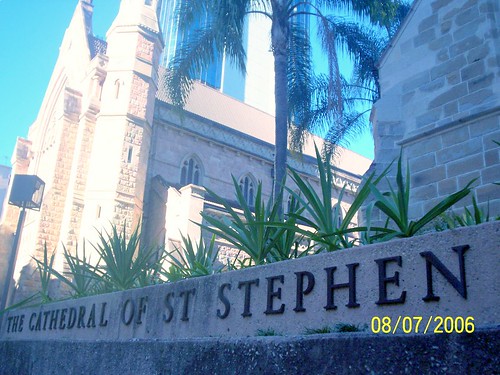
and turned left up Creek St, passing next to a famous stand of Moreton Bay Figs.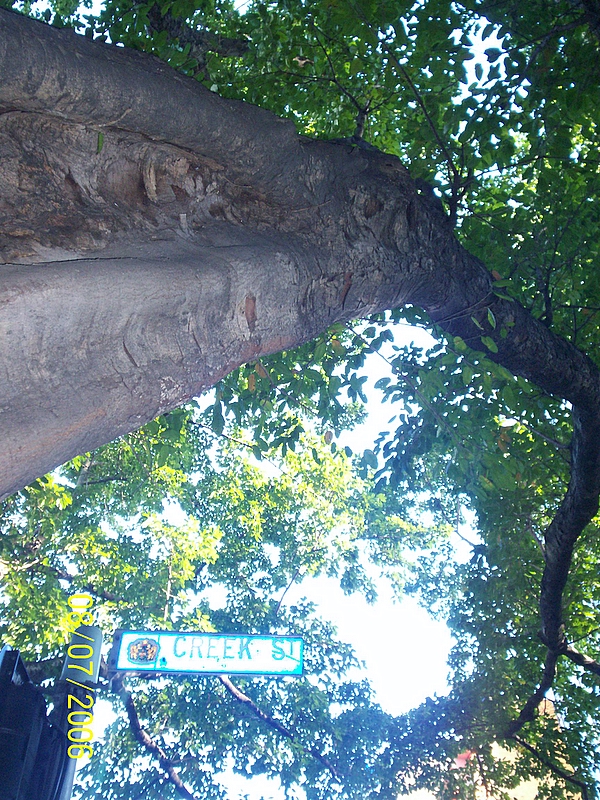
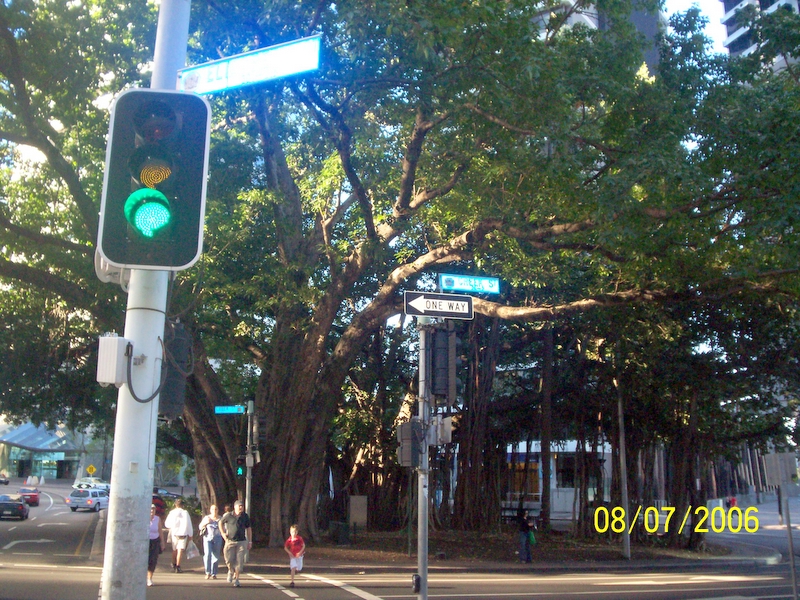
http://www.flickr.com/photos/jremigio/22093370/in/set-18890
left into Adelaide St, all the way down Adelaide St to turn left into North Quay, then right onto the Queen Victoria Bridge. After crossing the bridge, the march turned left into the Southbank Cultural Forecourt, then walked along the Clem Jones Promenade, briefly through the Arbour, (photos here), and finally to a grassy patch outside the Webb Building of Griffith University's Southbank Campus. Naturally, the march included chanting. Now maybe I am just not revolutionary enough, but most chants embarrass me. At least three of the different groups on the march had bullhorns, and were competing to get people chanting. Some of the chants I heard: 1-2-3-4 Johnny Howard out the door 5-6-7-8 Open Up the Baxter Gates. Pity about winning over any Liberal-voting refugee supporters, huh? If even the No borders! No Nations! A good idea. I thoroughly support a borderless world. However, it is NOT what is going to convince ordinary Australians to support the cause. Hey Hey! Ho Ho! Hey Hey! Ho Ho! I am thoroughly sick and tired of this old, ridiculous slogan. Of course, it can be used against anyone you are opposed to, at least if they have enough syllables in their name. But I remember this chant being used against Senator Vanstone time and time again over the last decade. She is still here. Maybe success should be our goal, instead of yelling in the streets? Say it loud! Say it Clear! Refugees are welcome here! The man who was leading this chant was starting to lose his voice. By this time, we had walked for at least half an hour, I had no idea where or when we were going to finish, and I was grumpy, and tired of self-righteous sloganeering. Perhaps that is why the words: Say it hoarse! Say it croaky! Think this march is kinda jokey! leapt into my head. Or maybe I'm just a bad person. No, really. This sort of chanting is what I did when I went to the football when I was eight. It can be great fun, and I plan to do a lot of it when Australia plays in the Rugby League test at Lang Park a week before the cricket Ashes start. But what are we doing chanting about politics in the streets? Was this just a gathering for activists to make a noise so they could feel good? Had anyone thought through what effect the gathering was likely to have on casual observers? I would suggest that if we must have chanting, we do it at rallies, instead of marching in the streets and blocking traffic and making people annoyed because their precious Saturday time is wasting away. Instead, we could hold workshops where we talk about the best and most effective ways to get our message across into the hearts and minds of ordinary people – in one-on-one conversations, in public meetings and when we are on the media, or creating it. Anyway, the march was too long for me – about 3.2 kilometres (roughly 2 miles). It seemed to me that only about 20% of the people who started made it to the end, but that was only a very rough guess, not based on any sort of count. I only stayed for the sake of the story, if I had just been a casual caring sort of person, I don't think I would have stayed to the end. But it was a good thing I did. After the frustration of the chanting, I did not want to listen to any more speeches – there was a forum in the grassy forecourt of Griffith University's Southbank Campus. So after watching some women dancers from Sudan, I started looking around. Trouble was, this part of the university is basically the art school, so there were at least 3 art galleries there. QCA Gallery – wrong Project Gallery – right building, wrong floor. A-ha. Lift. 7th Floor, Webb Building. Yup. Found it. Now that was a little hard to find, and I was deliberately looking hard for it. I think you should go and see this exhibition if you are in Brisbane, because it gives some good examples of work that might be able to cut through to some people. So at the bottom of the article, there are some maps to make it easy to find, with instructions and links to useful information. But first, you'll want to know why you should go.
Doomed Senator, Andrew Bartlett (Democrat, Queensland),
can see that the Liberals are divided, why can't the marchers?
No deportations!
Amanda Vanstone's Got to GO!
My version of this goes:
Mindless Chanting's Got to Go!
Well, clearly they are not, or we wouldn't have to have this rally. That is what we are trying to change, and I am not 100% certain that anyone was convinced by the chanting.
This is Durham's vision of one of those drowned in the Siev X. (Wiki)Does it make you angry, or uneasy?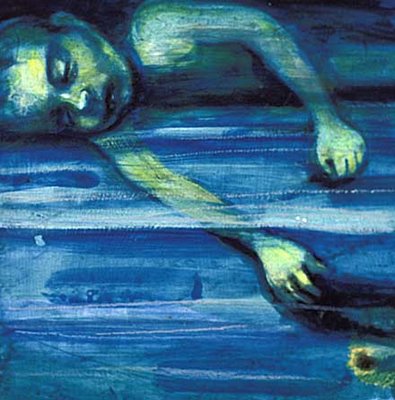
NOT public domain - from Kate Durham's website
How about this?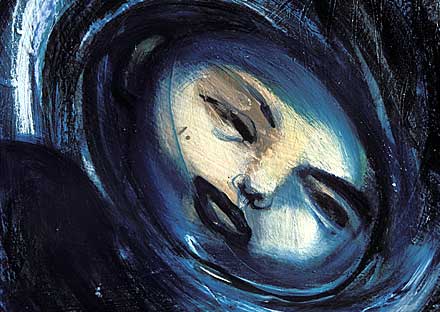
NOT public domain - from Kate Durham's website
"353 people drowned that night."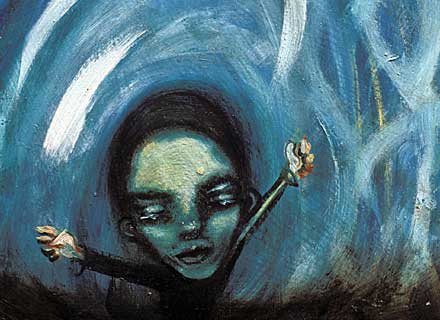
NOT public domain - from Kate Durham's website
Do we want to stop this, or do we just want to get angry?
NOT public domain - from Kate Durham's website
Do you think this might touch the heart of the average Australian?
NOT public domain - from Kate Durham's website
This is what this work looked like at another exhibition. This only shows 153 squares. The exhibition at Griffith Uni Southbank Campus has 273 - not everyone has a painting yet.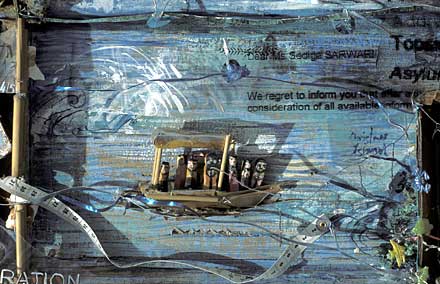
NOT public domain - from Kate Durham's website
Durham uses fragments of official correspondence, and 3-d models,
NOT public domain - from Kate Durham's website
including large 3-d refugee boats,
NOT public domain - from Kate Durham's website
which have lots of details to notice.
NOT public domain - from Kate Durham's website
Durham also scatters personal effects, textiles, and documents about the human side of refugees.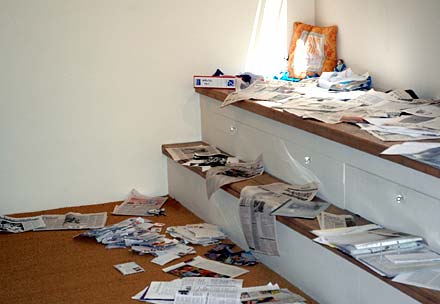
NOT public domain - from Kate Durham's website
What really got me were the 'letters from the Damned'. At the Griffith Uni/Southbank exhibition the letters are in arch files, not scattered around like this, but you can still read them and they are just as moving.
This is an overview of the area where the exhibition is.
The 'i' at the train station is right at the entrance to a path which leads straight to the university.
If you walk from Southbank, you will see the start of a path right next to the Southbank Arbour (the long curvy line right through the parklands). The winding path goes up the small hill to the grassy forecourt.
The 'i' at the bus station is right in between the two lifts - go down to Tribune St, and walk along Grey St to the entrance of the university.
This is a closer shot - you cannot see the path from the grassy forecourt to the entrance to the Webb building from here - but you can see where to look.
Brisbane Public Transport
Australian Street Directories
Southbank
Griffith University, Southbank Campus.
Go to the exhibition. You have until Wednesday, July 12th.
And then think very hard about what is going to actually convince Australians to support refugees.
Here's a place to begin.
When the Commonwealth Games were held in Melbourne in April, Sierra Leonean athletes ran away to hide in Australia. The Sierra Leone team was cheered at the end of the Games.
Maybe not all mainstream Australians are simple racists after all?
Keep your feeds open.


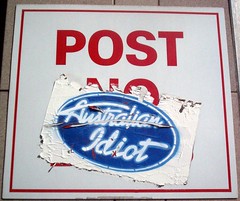

No comments:
Post a Comment